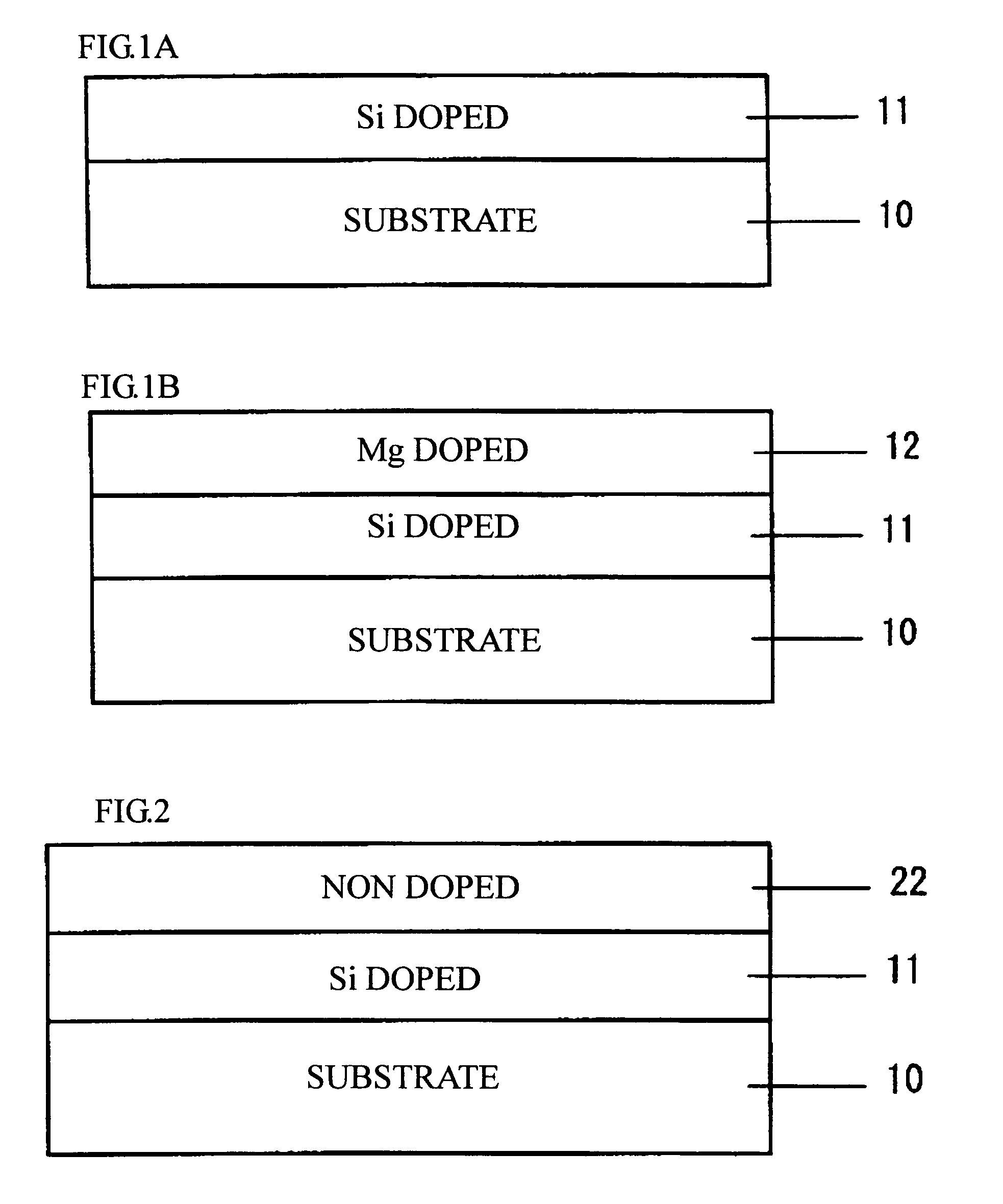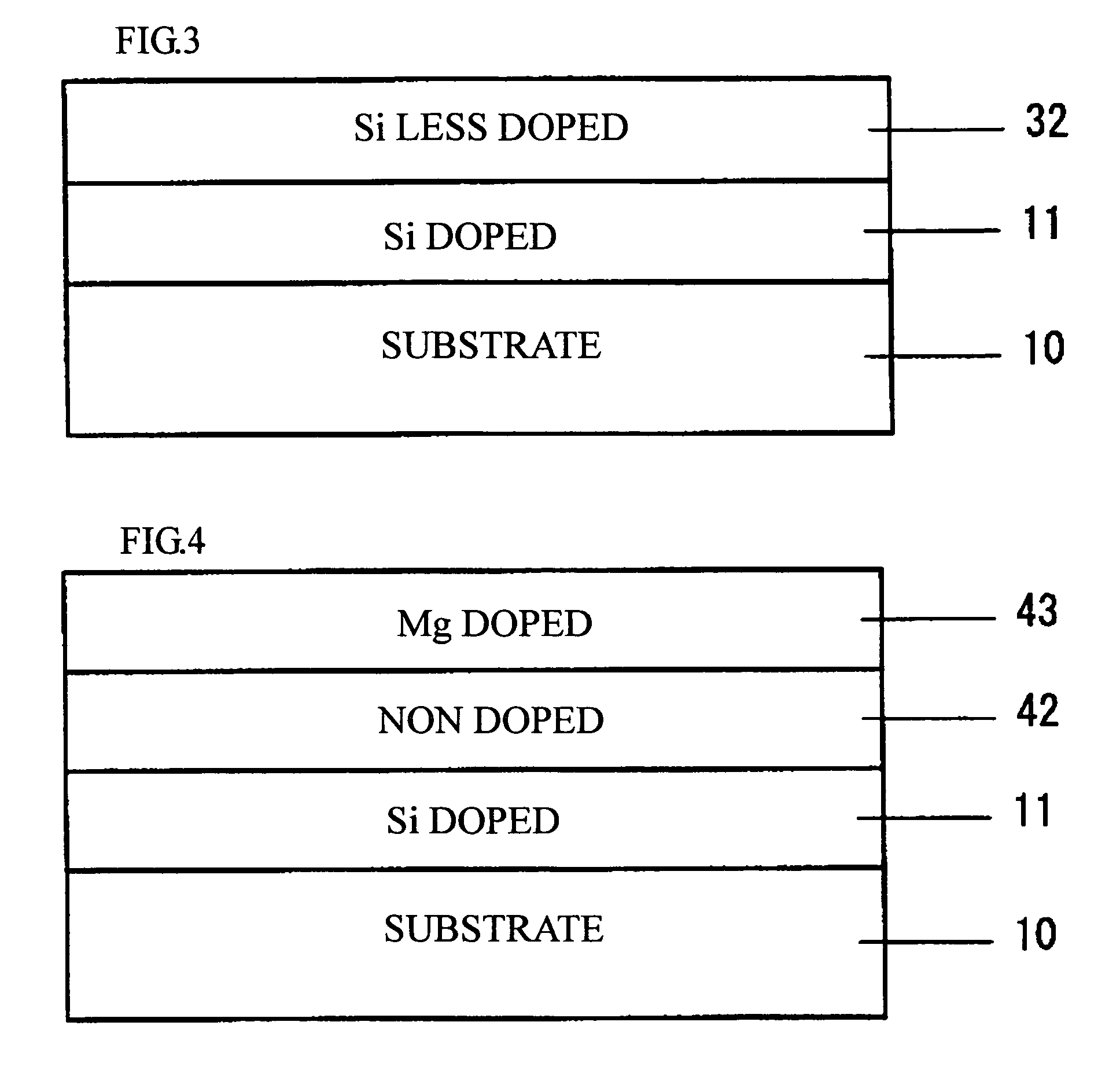Manufacturing method of group III nitride semiconductor
a manufacturing method and semiconductor technology, applied in the direction of polycrystalline material growth, chemically reactive gas growth, crystal growth process, etc., can solve the problems of iii nitride semiconductor, large number of threading dislocations, deterioration of surface flatness, etc., to control the crystalline quality and surface flatness of the second layer, and simplify the manufacturing process
- Summary
- Abstract
- Description
- Claims
- Application Information
AI Technical Summary
Benefits of technology
Problems solved by technology
Method used
Image
Examples
first exemplary embodiment
[0047]A sample according to the first exemplary embodiment was manufactured by the manufacturing method described below. At first, a sapphire substrate 10, whose surface was flat and was not worked, was prepared. The sapphire substrate 10 was annealed in hydrogen atmosphere so as to remove surface adsorbates. Then, a Si doped GaN layer (corresponding to the first layer) 11 was formed by MOCVD on the surface of the sapphire substrate 10 via buffer layer of AIN (not shown) (FIG. 1A). The Si concentration in the Si doped GaN layer 11 was set within the range from 1×1018 to 1×1020 / cm3 and the thickness of the Si doped GaN layer 11 was 1 μm. For the MOCVD process, the carrier gas was hydrogen gas and nitrogen gas, the nitrogen source was ammonia, the gallium source was TMG (trimethylgallium), and the dopant gas was silane (SiH4). The growth conditions such as the growth temperature and pressure were usually adopted conditions for the crystal growth of the group III nitride semiconductors...
second exemplary embodiment
[0059]A sample of the second exemplary embodiment is shown in FIG. 2. The sample of the second exemplary embodiment was same as the samples according to the first exemplary embodiment except for that the sample has a non-doped GaN layer 22 instead of the Mg doped GaN layer 12 in the first exemplary embodiment. The growth conditions such as the growth temperature and pressure for the non-doped GaN layer 22 was same as those of the first exemplary embodiment. In the crystal growth of the non-doped GaN layer 22, the three dimensional growth is relatively dominant but the tendency of the three dimensional growth is less than that of the Si doped GaN layer 11. Therefore, it is possible to gradually change the crystal growth mode from three dimensional growth to the weak three dimensional growth by stacking the Si doped GaN layer 11 ad the non-doped GaN layer 22 in this order. As a result, the number of the threading dislocation can be reduced and the high surface flatness can be achieved...
third exemplary embodiment
[0062]A sample of the third exemplary embodiment is shown in FIG. 3. The sample of the third exemplary embodiment is same as the exemplary embodiment 1 except for that the sample has a Si less doped GaN layer 32 instead of the Si doped GaN layer 12 in the first exemplary embodiment. The Si concentration in the Si less doped GaN layer 32 is lower than that in the Si doped GaN layer 11. The Si less doped GaN layer 32 less favors the three dimensional growth as compared to the Si doped GaN layer 11. Therefore, it is possible to gradually change the growth mode from the three dimensional growth to the weak three dimensional growth by stacking the Si doped GaN layer 11 and the Si less doped GaN layer 32 in this order. As a result, it is possible to reduce the number of the threading dislocation and improve the surface flatness.
[0063]The crystalline quality of the Si less doped GaN layer 32 in the c-plane of a sample 3A according to the third exemplary embodiment was evaluated. In the sam...
PUM
| Property | Measurement | Unit |
|---|---|---|
| thickness | aaaaa | aaaaa |
| surface flatness | aaaaa | aaaaa |
| thickness | aaaaa | aaaaa |
Abstract
Description
Claims
Application Information
 Login to View More
Login to View More - R&D
- Intellectual Property
- Life Sciences
- Materials
- Tech Scout
- Unparalleled Data Quality
- Higher Quality Content
- 60% Fewer Hallucinations
Browse by: Latest US Patents, China's latest patents, Technical Efficacy Thesaurus, Application Domain, Technology Topic, Popular Technical Reports.
© 2025 PatSnap. All rights reserved.Legal|Privacy policy|Modern Slavery Act Transparency Statement|Sitemap|About US| Contact US: help@patsnap.com



